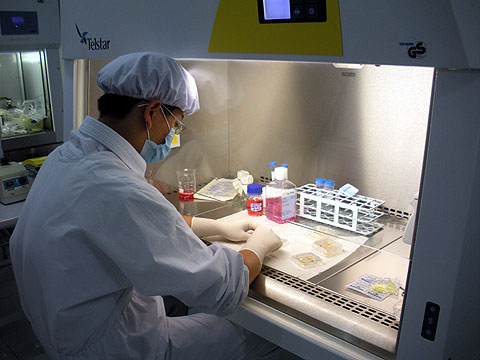Treating the disease by the membranes of the fetus
After three years of research, scientists in Ho Chi Minh City have perfected the technique of treating fetal membranes to cultivate skin cells, corneas . burns, keratitis. This achievement has opened a new direction for the application of biotechnology in medical treatment.
This is the research result of the Stem Cell Research and Application Laboratory, Ho Chi Minh City University of Natural Sciences, led by Dr. Phan Kim Ngoc as the project leader.
Create new cells with amniotic membranes
'When I started working on the topic, the research team went to Tu Du Obstetrics Hospital to ask for amniotic membranes. The women bluntly refused and we had to persuade them to complete it , 'recalls master Tran Le Bao Ha.
After collection, the amniotic membrane is washed, treated with the epithelial layer with a special solution and in a separate procedure. Through this treatment, amniotic membranes become transparent and are used as substrates ('substrates') to feed many types of cell growth).

Clean and transplant cells to amniotic membranes.Photo: T. Ngoc
The team tested culturing mouse skin cells for development on the treated amniotic membranes and then grafted them on the rat body. As a result, burns on mice did not ooze, no edema, no pus; The pale pink skin is spread out from the edges of the wound, helping to close the mouth.
To test on people, the team sent experts to Japan to learn more experiences, to achieve the desired success.
Master Ngoc said: The cells will be taken from the skin, cornea, with an area of 1-2 cm 2 of the patient's own body. Then, they are transplanted and grown on the treated amniotic membrane with an area of 50-100 times.
After 21 days, these cells will be grafted back to the patient's body in vulnerable areas. Clinical trials in many patients have shown good results.
Bring practical value in medicine
According to specialist Dr. Tran Doan Dao, Head of Burns Department, Cho Ray Hospital, developed countries like England, USA, Australia . tend to use synthetic materials rather than amniotic membranes.
However, Master Phan Kim Ngoc, project manager, said that amniotic membranes are easy materials in Vietnam and their collection is not legally binding as in other countries.
Master Ngoc also said that there are also some units in the country studying and applying amniotic membrane to treat wounds and burns.
'The greatest success of our research is the treatment of amniotic membranes to eliminate harmful factors and become the appropriate' substrate 'for culturing patients' own cells when skin grafting and cupping. To treat illness , Dr. Ngoc said.
Dr. Do Phuong Thang, Head of Burns Department, Hospital 175, said that the study has been applied for treatment in the past few years, with many cases and all have good treatment results.
As for Dr., Dr. Tran Son Thach, Director of Hung Vuong Hospital commented: With raw materials that can be taken advantage of fetal byproducts often abandoned after birth, research results have brought value. practical in medicine and achieved much greater economic efficiency than imported products. Tu Du and Hung Vuong hospitals have 90,000 births / year, this is a significant source of materials for the research and application of this new technology.
According to Dr. Do Hong Lan Chi, Deputy Head of Science and Technology Department, National University of Ho Chi Minh City, should conduct patent registration for research projects and the school will support costs and registration procedures.
- The fetus also knows how to yawn
- The fetus was discovered in a 4-year-old boy's abdomen
- Herbicides cause open stomach disease in the fetus
- Zika virus can cross each other maternity
- Make fetus with a 3D printer
- Desalination in seawater with nano membranes
- New measures to diagnose Down syndrome in the fetus
- Video: A close-up of life inside the fetus
- The fetus 'sleep cycle'
- Preterm birth can be caused by bacteria
- Interesting association of fetal development through fruits
- Helpless doctors, parents studying and treating children themselves
 Green tea cleans teeth better than mouthwash?
Green tea cleans teeth better than mouthwash? Death kiss: This is why you should not let anyone kiss your baby's lips
Death kiss: This is why you should not let anyone kiss your baby's lips What is salmonellosis?
What is salmonellosis? Caution should be exercised when using aloe vera through eating and drinking
Caution should be exercised when using aloe vera through eating and drinking